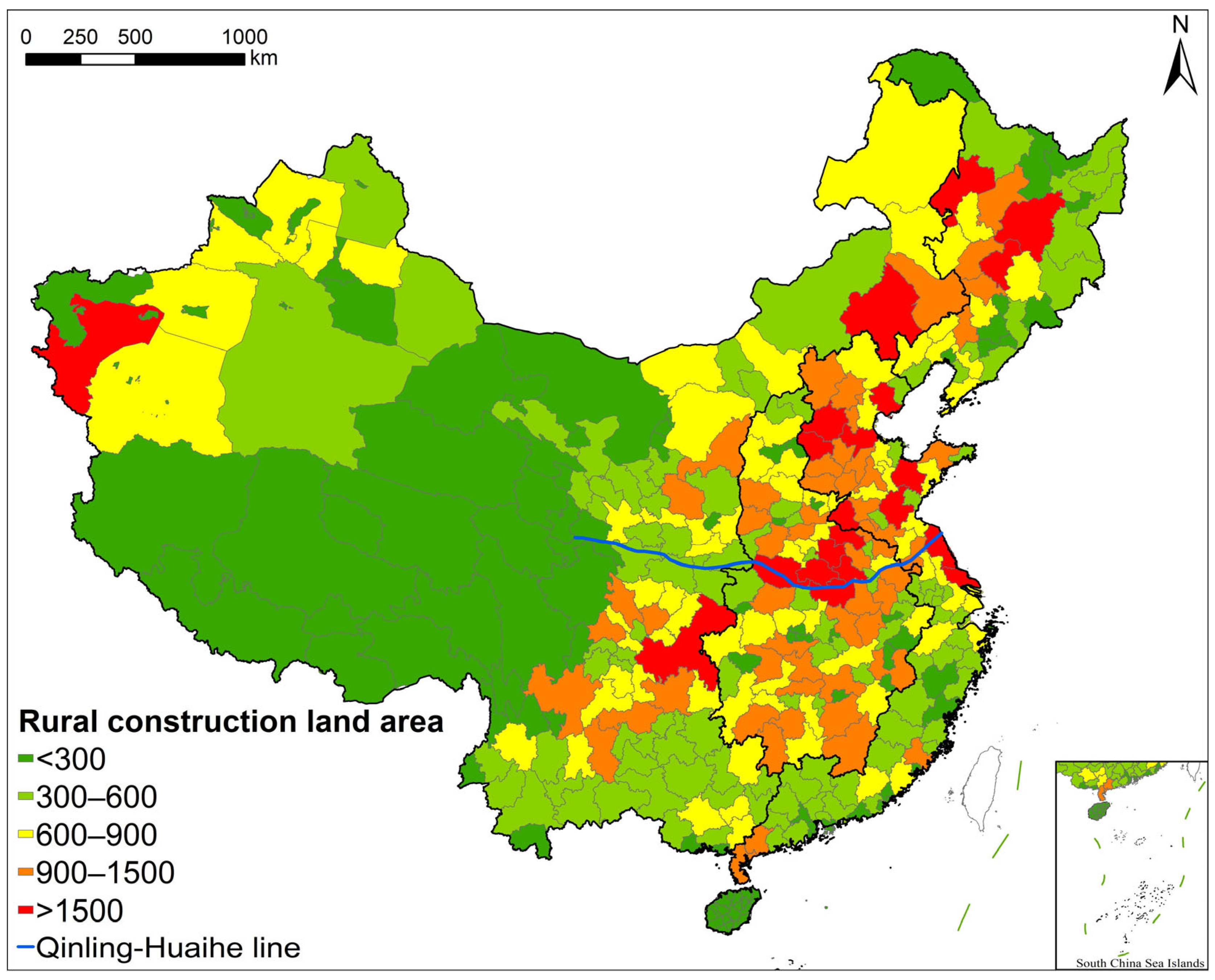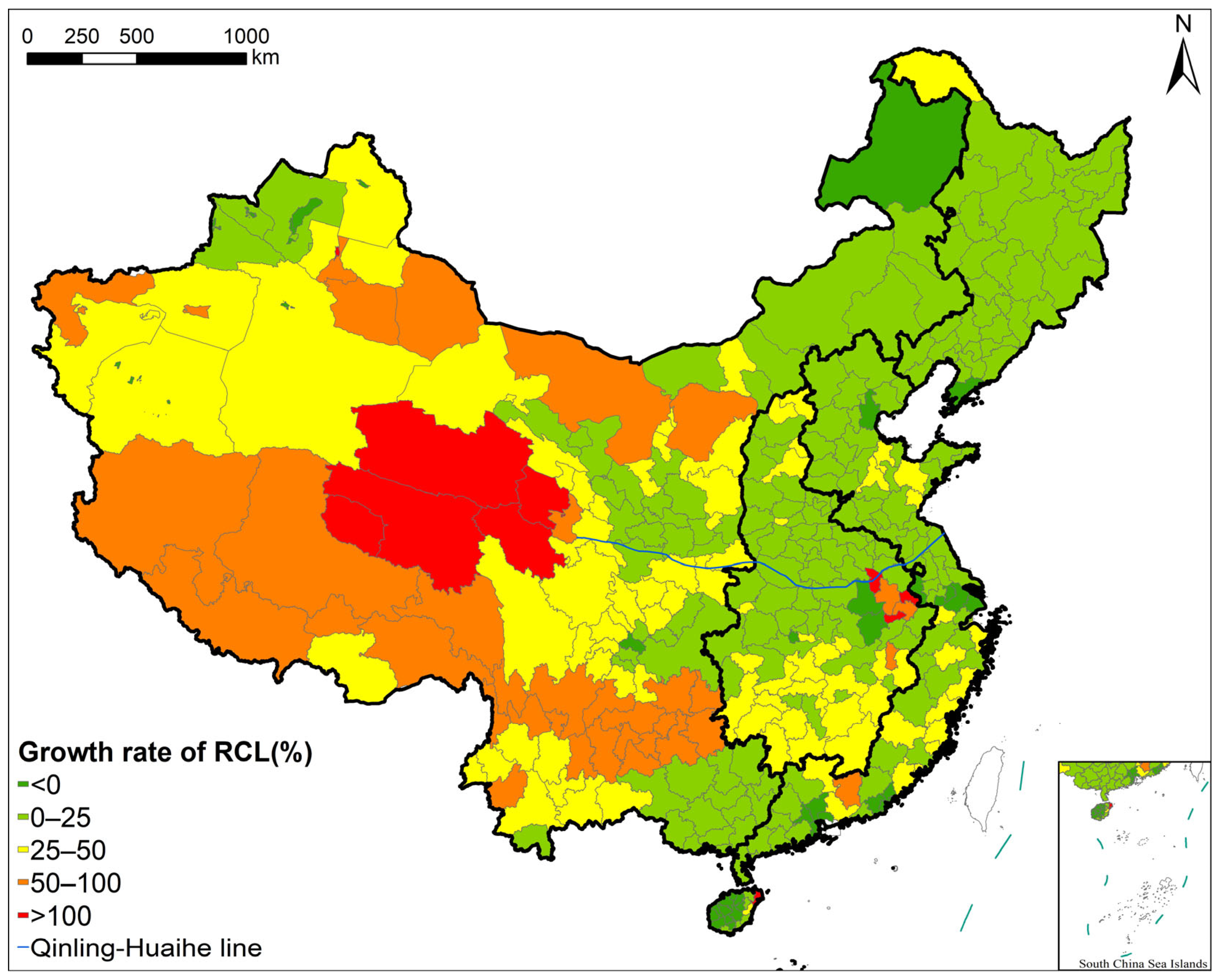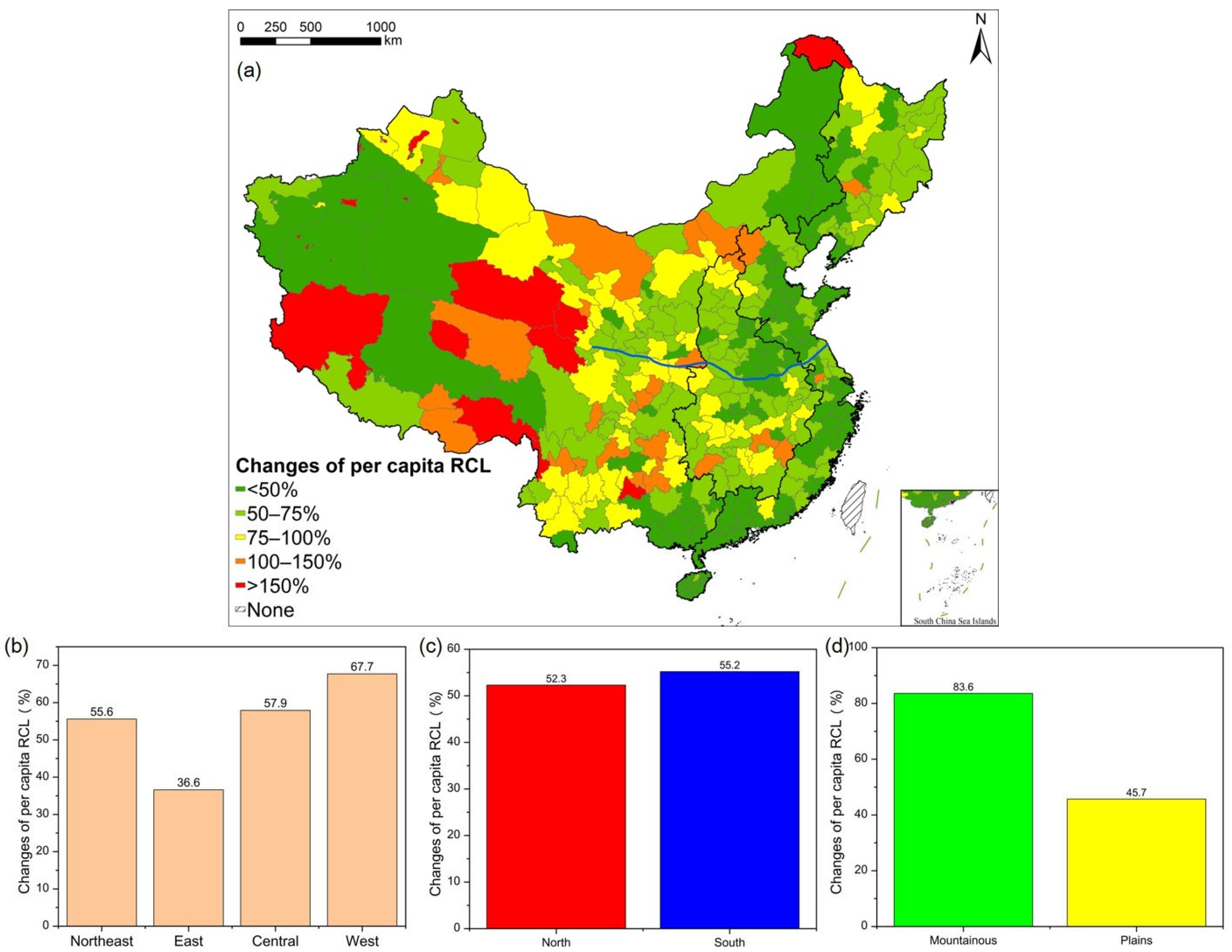Dramatic Decoupling Between Population and Construction Land in Rural China
Abstract
1. Introduction
2. Research Method and Data
3. Research Results
3.1. Current Situation of RCL in China
3.2. Current Situation and Changes in per Capita RCL
3.3. Decoupling Relationships Between RCL and Rural Population
4. Discussion
4.1. Terrain
4.2. Geographic Location
4.3. Urbanization Rate
4.4. Per Capita Income
4.5. Decoupling Index
5. Conclusions
- (1)
- A dramatic decoupling phenomenon between RCL and the rural population is shown in China. Despite the rapid decline in China’s rural population, RCL has grown rapidly. From 2010 to 2020, per capita RCL has grown fast at 53.0%.
- (2)
- There are strong regional differences in per capita RCL. There is a substantial difference between per capita RCL in the plains and mountainous areas, with the latter being 1.1 times higher than the former. The higher the latitude, the larger the per capita RCL, with northern areas being 1.4 times that of southern areas. Among the four major regions, the Northeast has the largest per capita RCL, while the East has the smallest.
- (3)
- More than 80% of prefecture-level cities in China show a negative decoupling relationship between RCL and rural population.
- (4)
- Per capita income has no significant impact on per capita RCL, indicating that RCL grows regardless of whether farmers’ income is high or low. In some provinces in western China, rural residential investment accounts for more than 10% of farmers’ income, imposing a significant burden on their livelihoods.
Supplementary Materials
Author Contributions
Funding
Data Availability Statement
Conflicts of Interest
References
- Zhou, Y.; Huang, H.; Liu, Y. Dynamic Mechanism and Present Situation of Rural Settlements Evolution in China. Acta Geogr. Sin. 2020, 75, 2206–2223. [Google Scholar] [CrossRef]
- López, E.; Bocco, G.; Mendoza, M.E.; Velázquez, A.; Aguirre-Rivera, J.R. Peasant emigration and land-use change at the watershed level: A GIS-based approach in Central Mexico. Agric. Syst. 2006, 90, 62–78. [Google Scholar] [CrossRef]
- Eurostat. Predominantly Rural Regions Experience Depopulation. News Article of the Official Website of the European Union. 2023. Available online: https://ec.europa.eu/eurostat/web/products-eurostat-news/w/ddn-20230117-2 (accessed on 20 December 2024).
- Capello, R.; Cerisola, S. Industrial transformations and regional inequalities in Europe. Ann. Reg. Sci. 2022, 70, 15–28. [Google Scholar] [CrossRef]
- Somvanshi, S.S.; Kumari, M.; Sharma, R. Spatio-temporal analysis of rural–urban transitions and transformations in Gautam Buddha Nagar, India. Int. J. Environ. Sci. Technol. 2023, 21, 5079–5088. [Google Scholar] [CrossRef]
- Deng, X.; Huang, J.; Rozelle, S.; Uchida, E. Growth, population and industrialization, and urban land expansion of China. J. Urban Econ. 2008, 63, 96–115. [Google Scholar] [CrossRef]
- Liu, S.-c.; Xiao, W.; Ye, Y.; He, T.; Luo, H. Rural residential land expansion and its impacts on cultivated land in China between 1990 and 2020. Land Use Policy 2023, 132, 106816. [Google Scholar] [CrossRef]
- Yao, P. Village planning under the national spatial planning system. South China Agric. 2022, 16, 149–151. [Google Scholar]
- Song, W.; Liu, M. Assessment of decoupling between rural settlement area and rural population in China. Land Use Policy 2014, 39, 331–341. [Google Scholar] [CrossRef]
- Zhang, Y.; Li, M.; Zhen, A. Analysis of the Influencing Factors of Paid Withdrawal and Use of Rural Homestead Land. Econ. Geogr. Available online: http://kns.cnki.net/kcms/detail/43.1126.k.20230525.1939.002.html (accessed on 17 September 2023).
- Huang, Q.; Li, M.; Chen, Z.; Li, F. Land Consolidation: An Approach for Sustainable Development in Rural China. AMBIO 2011, 40, 93–95. [Google Scholar] [CrossRef]
- Xu, L.; Xiao, S. On the Contradiction between Migrant Workers’ Surplus of Rural Housing and Shortage of Urban Housing. J. Anhui Agric. Univ. Soc. Sci. Ed. 2012, 21, 15–18. [Google Scholar]
- Xiao, Y.; Xu, Y.; Wu, B. Spatial patterns, influencing factors and type classification in villages of Hainan Island, China. Geogr. Sin. 2023, 43, 1410–1422. [Google Scholar]
- Li, H. Research on the scale of rural construction land under the national spatial planning system. Rural. Econ. Technol. 2021, 32, 24–26. [Google Scholar]
- Gu, G.; Wu, B.; Chen, Q.; Zhang, W.; Lu, R.; Lu, S.-q.; Feng, X.; Liao, W. Spatial differences and influence mechanisms of construction land development intensity in China, 2002–2020. Sci. Rep. 2023, 13, 11153. [Google Scholar] [CrossRef]
- Li, X.; Kuang, X.; Ma, X.; Li, C. Are there interactions between the urban and rural construction land use transition? Evidence from Jiangsu province in China. Habitat Int. 2024, 148, 103092. [Google Scholar] [CrossRef]
- Xue-la, T. The Change and Driving Forces of Rural Residential Area Under the Background of Rapid Urbanization:A Case Study of the Changsha-Zhuzhou-Xiangtan Urban Agglomeration. Sci. Geogr. Sin. 2014, 34, 309–315. [Google Scholar]
- Xi, N.; Ainong, L.; Yu, C.; Wei, D. Design and Compilation of Digital Mountain Map of China (1∶6 700 000) in Vertical Layout. Remote Sens. Technol. Appl. 2016, 31, 451–458. [Google Scholar]
- Guo, Y.; Tang, X.; Chen, K.; Li, Z.; Lin, S. Characteristics and influencing factors of rural settlement spatial reconstruction in Wuhan City. Econ. Geogr. 2018, 38, 180–189. [Google Scholar]
- Shi, L.; Wang, Y. Evolution characteristics and driving factors of negative decoupled rural residential land and resident population in the Yellow River Basin. Land Use Policy 2021, 109, 105685. [Google Scholar] [CrossRef]
- Wang, P.; Zhang, J.; Sun, F.; Cao, S.; Que, Y.; Wang, C.; Xu, D. Spatial Distribution and the Impact Mechanism of Traditional Villages in Southwest China. Econ. Geogr. 2021, 41, 204–213. [Google Scholar]
- Hou, X.; Yu, Z.; Li, Y.; Yuan, L.; Sun, C. Spatial pattern and mechanism of depopulation in the mountainous counties in China. Geogr. Res. 2024, 43, 1205–1224. [Google Scholar]
- Zhao, P.; Zhang, M. The Role of Villages and Townships in Informal Land Development in China: An Investigation on the City Fringe of Beijing. Sustainability 2016, 8, 255. [Google Scholar] [CrossRef]
- Yin, L.; Wei, W.; Zhao, L.; Xia, J.; Bo, L. Characteristics, regional differences, and influencing factors of agricultural spatial evolution in China from 2000 to 2020. Geogr. Res. 2024, 43, 1225–1246. [Google Scholar]
- Meng, F. Improving agricultural mechanization level to promote agricultural sustainable development. Trans. Chin. Soc. Agric. Eng. Trans. CSAE 2017, 37, 57. [Google Scholar]
- Wang, M.; Mizoguchi, M.; Lai, W. A Study on the Feature of Spatial Structure and Its Formative Factors in Northern Chinese Farmhouses—A Perspective of Function and Arrangement. J. Hum. Settl. West China 2015, 30, 63–70. [Google Scholar]
- Liu, Y.; Yu, H.; Liu, D.; Zhu, L. Spatial differentiation mechanism of development intensity pattern of construction land in Northeast China. Acta Geogr. Sin 2018, 73, 818–831. [Google Scholar]
- Li, X.; Ma, X. The mechanism of excessive expansion of construction land leading to inefficient economic growth. Urban Probl. 2015, 8, 2–7. [Google Scholar] [CrossRef]
- Lou, F.; Li, X.; Chen, X. Comparison on Spatial Evolution of Rural Settlements between the Flat and the Mountainous Areas: Evidence from Yanjin County and Baofeng County, Henan Province. Econ. Geogr. 2017, 37, 158–166. [Google Scholar]
- Wang, D.; Chen, C.; Findlay, C. A review of rural transformation studies: Definition, measurement, and indicators. J. Integr. Agric. 2023, 22, 3568–3581. [Google Scholar] [CrossRef]
- Yan, Q.; Li, J. Empirical Study on the Over construction of Self built Houses in Rural Areas of China: A Case Study of Jiangxi Province. Technol. Innov. Appl. 2015, 4, 14–16. [Google Scholar] [CrossRef]
- Yang, C.; Liu, X. Rural Settlements Landscape Evolution and Driving Factor in Beibei District of Chongqing. Mt. Res. 2017, 35, 890–898. [Google Scholar]
- Bibri, S.E.; Krogstie, J.; Kärrholm, M. Compact city planning and development: Emerging practices and strategies for achieving the goals of sustainability. Dev. Built Environ. 2020, 3, 100021. [Google Scholar] [CrossRef]




| Data Type | Data | Unit | Time | Source |
|---|---|---|---|---|
| Natural Geographic Data | Latitude and longitude | 2020 | ArcGIS | |
| Land Use Data | Area of RCL | m2 | 2010, 2020 | The second and third national land surveys |
| Socioeconomic Data | Rural population | people | 2010, 2020 | The sixth and seventh censuses |
| Per capita land resources | m2 | 2010, 2020 | The second and third national land surveys | |
| Urbanization rate | % | 2010, 2020 | China Urban Statistical Yearbook | |
| Per capita income of rural residents | Yuan per person | 2010, 2020 | Panel data on residents’ income at the prefecture-level cities scale (1999–2020) | |
| Investment in rural housing | Ten thousand yuan | 2010, 2020 | China Fixed Assets Investment Statistical Yearbook | |
| Vector Data | National administrative divisions | 2020 | Geospatial Data Cloud Platform | |
| Mountain Distribution | 2015 | Dataset of “Digital Mountain Map of China” [18] |
| Types of Arguments | Argument Names | Definition |
|---|---|---|
| Natural factors | Longitude | Location longitude |
| Latitude | Location latitude | |
| Terrain | Set two dummy variables: plain and mountainous areas, with mountainous areas as the control variable | |
| Socioeconomic factors | Per capita land resources | The total land area owned by each citizen within the administrative region |
| Per capita income | The abbreviation for per capita income of rural residents | |
| Urbanization Rate | Proportion of urban population to total regional population | |
| Regional dummy variable | Geographical region | Set 3 dummy variables, Northeast, East, and Central, with Western as the control variable |
| Type | Relationship | Distribution Region | Number of Prefecture-Level Cities |
|---|---|---|---|
| Decoupling | Strong decoupling | Shanghai, Guangdong | 4 |
| Weak decoupling | Guangdong, Hainan, Tibet | 4 | |
| Recessive decoupling | Guangdong, Tianjin | 4 | |
| Negative decoupling | Strong negative decoupling | nationwide | 320 |
| Weak negative decoupling | Inner Mongolia, Liaoning, Jiangsu, Anhui, Guangdong, Sichuan, Xinjiang | 12 | |
| Expansive negative decoupling | Zhejiang, Anhui, Shandong, Hainan, Guizhou, Tibet, Gansu, Xinjiang, Qinghai, Ningxia | 20 | |
| Coupling | Expansion coupling | Fujian | 1 |
| Recessive coupling | 0 |
| (a) | ||||||
|---|---|---|---|---|---|---|
| Independent Variable | Longitude | Latitude | Per Capita Land Resources | Per Capita Income | Urbanization Rate | |
| Correlation | Longitude | 1.00 | −0.02 | 0.26 | −0.16 | −0.16 |
| Latitude | −0.02 | 1.00 | −0.18 | 0.22 | −0.35 | |
| Per capita land resources | 0.26 | −0.18 | 1.00 | −0.03 | −0.01 | |
| Per capita income | −0.16 | 0.22 | −0.03 | 1.00 | −0.41 | |
| Urbanization rate | −0.16 | −0.35 | −0.01 | −0.41 | 1.00 | |
| Covariances | Longitude | 0.25 | −8.00 × 10−3 | 8.23 × 10−6 | −5.75 × 10−5 | −3.11 |
| Latitude | −8.00 × 10−3 | 0.49 | −7.95 × 10−6 | 1.2 × 10−4 | −9.58 | |
| Per capita land resources | 8.23 × 10−6 | −7.95 × 10−6 | 3.86 × 10−9 | −1.40 × 10−5 | −2.13 × 10−5 | |
| Per capita income | −5.75 × 10−5 | 1.2 × 10−4 | −1.40 × 10−5 | 5.39 × 10−7 | −0.01 | |
| Urbanization rate | −3.11 | −9.58 | −2.13 × 10−5 | −0.01 | 1541.93 | |
| (b) | ||||||
| Type | Independent variable | B | Beta | t | Significance | VIF |
| Natural factors | Longitude | −1.87 | −0.17 | −2.56 | 0.01 | 2.50 |
| Latitude | 6.55 | 0.43 | 7.50 | <0.01 | 1.91 | |
| Terrain | 13.13 | 0.06 | 1.24 | 0.02 | 1.26 | |
| Socioeconomic factors | Per capita land resources | 3.23 × 10−4 | 0.23 | 5.22 | <0.01 | 1.13 |
| Per capita income | −7.94 × 10−5 | −5.00 × 10−3 | −0.11 | 0.92 | 1.38 | |
| Urbanization Rate | 43.75 | 0.06 | 1.11 | <0.01 | 1.44 | |
| Regional dummy variable | D1 (Northeast) | 70.56 | 0.19 | 2.93 | <0.01 | 2.43 |
| D2 (East) | −2.03 | −8.00 × 10−3 | −0.12 | 0.90 | 2.70 | |
| D3 (Central) | 8.67 | 0.03 | 0.53 | 0.59 | 2.04 | |
Disclaimer/Publisher’s Note: The statements, opinions and data contained in all publications are solely those of the individual author(s) and contributor(s) and not of MDPI and/or the editor(s). MDPI and/or the editor(s) disclaim responsibility for any injury to people or property resulting from any ideas, methods, instructions or products referred to in the content. |
© 2025 by the authors. Licensee MDPI, Basel, Switzerland. This article is an open access article distributed under the terms and conditions of the Creative Commons Attribution (CC BY) license (https://creativecommons.org/licenses/by/4.0/).
Share and Cite
Han, J.; Tan, M. Dramatic Decoupling Between Population and Construction Land in Rural China. Land 2025, 14, 605. https://doi.org/10.3390/land14030605
Han J, Tan M. Dramatic Decoupling Between Population and Construction Land in Rural China. Land. 2025; 14(3):605. https://doi.org/10.3390/land14030605
Chicago/Turabian StyleHan, Jiatong, and Minghong Tan. 2025. "Dramatic Decoupling Between Population and Construction Land in Rural China" Land 14, no. 3: 605. https://doi.org/10.3390/land14030605
APA StyleHan, J., & Tan, M. (2025). Dramatic Decoupling Between Population and Construction Land in Rural China. Land, 14(3), 605. https://doi.org/10.3390/land14030605






